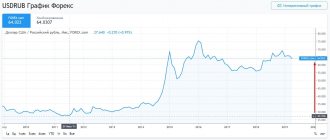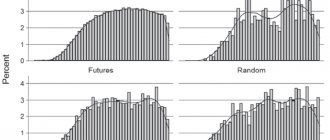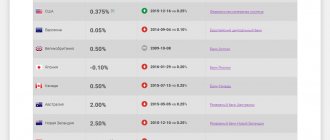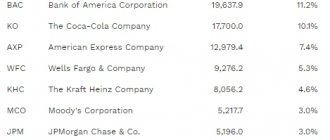| Moody's Investors Service | |
| Type | public company |
| Exchange listing | NYSE: MCO |
| Base | 1909; founder - John Moody (1868-1958) |
| Founders | John Moody [d] |
| Location | USA New York, 250 Greenwich Street (new International Trade Center) |
| Key figures | Raymond McDaniel, Jr. (chief executive officer); Michael Madeline (President and Chief Operating Officer) |
| Industry | international rating agency |
| Turnover | $2 billion (2010) |
| Affiliated companies | Moody's Investors Service [d], Moody's Japan [d], Moody's SF Japan [d], and Moody's Analytics |
| Website | Moody's in Russia |
| Media files on Wikimedia Commons | |
Moody's
(Russian: Moody's) is an international rating agency;
full name - Moody's Investors Service
. Moody's is a subsidiary of Moody's Corporation. Engaged in credit ratings, research and risk analysis. Moody's, along with Standard & Poor's and Fitch Ratings, is one of the "big three" international rating agencies [1].
The Chief Executive Officer of Moody's Investor Services since October 2007 has been Raymond W. McDaniel, Jr., who has also served as Chief Executive Officer of Moody's Corporation (since April 2005). The President and Chief Operating Officer of Moody's Investors Services since June 2021 is Robert Fauber [2].
The agency employs more than 4,500 experts in 26 countries.
The Moody's group of companies also includes the analytical service Moody's Analytics, the research center Moody's Research Labs Inc. and the Moody's Foundation. In 2014, the total number of employees of Moody's Corporation was about 9.9 thousand people, the corporation's turnover was equal to 3.3 billion US dollars [3].
In Russia and the CIS, Moody's is represented by its Russian branch, which assigns Moody's ratings on a global scale, as well as by the Moody's Interfax Rating Agency, which assigns credit ratings on a national scale. The second shareholder of Moody's Interfax, which traces its history back to the Interfax rating agency created in 1997, is the Interfax information group (49% of shares). Moody's is the only one of the "big three" rating agencies that has subsidiaries in Russia [4].
Moody's presentation
The history of the Moody's rating agency began at the very beginning of the 20th century . In 1900, Moody's Manual of Industrial and Miscellaneous Securities, authored by American financial analyst John Moody, was published. Soon after, John Moody & Company was born, specializing in publishing statistical information on stocks and bonds of government agencies and private businesses.
Within three years, Moody's publication reached the national level - it was instantly picked up by analysts, brokers and investors from the Atlantic to the Pacific coast. Financial markets grew stronger and grew, the number of brokers and traders grew rapidly, and in this business, and not only, as we know, whoever owns the information owns the world.
The financial crisis of 1907 severely crippled John Moody & Company . Unable to find new investors, John Moody sold the business. There was not enough working capital to keep the company afloat - paying salaries, renting premises, etc. The crisis is a crisis, but the high demand for financial market statistics has not gone away, and two years later Moody returns with a new company, Moody's Analyzes Publishing Company.
The year 1909 is listed as the official birth of Moody's Investors Service . After analyzing the reasons that led to the closure of the business in 1907, Moody found a way to maintain capital at a sufficient level. If previously all his profit came from sales of the printed publication, now he began to issue paid subscriptions and could calculate the profitability of his enterprise in advance.
By 1924, all US debt market bonds had a credit rating from Moody's! As of 2021, Moody's has offices in 40 countries, and its workforce exceeds 11.1 thousand people. Financial turnover - $4.8 billion.
Market capitalization (February 2020) – about 49 billion US dollars.
Criticism [edit | edit code]
Before the financial crisis began in 2007, companies rated mortgage bonds too high and held them for months after the mortgage market collapsed. As a result of the bankruptcy of the investment bank Lehman Brothers, a large number of bankrupt clients of the bank filed lawsuits against the rating agency. [7]
The international rating agency Moody's Investors Service has been counting its activities since 1900. Moody's Investors Service is one of the world's most respected and widely used sources of credit ratings, research and risk analysis materials.
The agency's ratings and research track debt obligations covering more than 110 countries, approximately 12,000 corporate issuers, 25,000 publicly traded issuers, and more than 106,000 structured finance obligations.
Moody's rating scale
The most popular rating is long-term credit. Based on it, investors make a conclusion about the reliability of the issuer in the medium and long term.
Moody's rating is divided into two main credit levels:
- Investment.
- Speculative.
The first group is securities that are attractive for investment, but with reservations - you need to take into account the specific rating. The second group is risky securities that can attract speculators (you can make good money on high interest rates, but the risks are also high).
Moody's credit ratings.
| Rating | Description of the rating |
| 1. Investment level of financial assets | |
| Ahh | The highest level of creditworthiness, no risks for investors |
| Aa1, Aa2, Aa3 | High level with extremely low risk |
| A1, A2, A3 | Average level of creditworthiness, but risks for investors are still low |
| Baa1, Baa2, Baa3 | Average level, moderate risks |
| 2. Speculative level | |
| Ba1, Ba2, Ba3 | There is a credit risk |
| B1, B2, B3 | High credit risk |
| Saa1, Saa2, Saa3 | Low quality securities with high credit risk |
| Ca | The probability of debt servicing remains, but the risks of partial or complete default are very high |
| WITH | There is virtually no prospect of debt repayment |
Moody's as an investment guide
The relationship between the US bond market and the international rating agencies developed further in 1930. Due to the growth of the banking market and the prospects for investment finance projects, investors renewed calls for increased transparency, leading to the creation of the Securities and Exchange Commission (SEC).
As a result, a new rule was introduced in 1936 prohibiting banks from investing in speculative securities (“junk bonds” in modern terminology), which was the starting point for the emergence of separate ratings more familiar to modern investors. Banks are only allowed to invest in investment grade bonds rated by Moody's, along with a standard rating from Fitch. In subsequent decades, similar requirements were adopted for all agencies.
In 1962, the Moody's rating agency was purchased by Dun & Bradstreet, a company engaged in collecting and cataloging credit information. Despite this, organizations still operate largely independently of each other.
In the late 1960s and 1970s, the number of issuers of securities increased greatly, which led to the consolidation of rating agencies, whose jurisdiction began to extend not only to the United States, but throughout the world.
The activities of rating agencies have become clearly monetized: in 2005, Moody's provided statistics that made it clear that 90% of the income of international rating agencies was derived from fees from issuers.
Moody's ratings
Moody's calculates a huge number of credit ratings:
- Long-term debt obligations of government and corporate issuers;
- Medium-term debt obligations;
- Short-term debt obligations;
- Municipal ratings;
- Corporate ratings;
- Probability of default;
- Estimation of losses in case of default;
- Bank deposits;
- Financial stability of banks, insurance companies;
- Equity funds;
- Market risks;
- Quality of services, etc.
Rating process
The initial assignment of a rating occurs through the interaction of the recipient (company) and agency analysts. The process includes the following steps:
- Introductory meeting. The Business Development Officer provides information on Moody's procedures. The issuer is informed what information needs to be provided to form an objective picture of the company. At this stage, the main goal is for the recipient of the assessment to clearly understand how the credit analysis is carried out. The first meeting takes from half a day to a full day (including site visits). Particular attention will be paid to the following points:
- Stability and predictability of cash flows, ability to make debt payments.
- Profitability of core activities.
- Cost structure, the ability to optimize costs.
- Balance sheet forecast for the next 3 years with an analysis of sources of debt repayment.
- Development strategy and management’s ability to effectively implement it.
- Decision of the credit committee. After the first meeting, analysts conduct further research and communicate with the company’s financial department and managers. The experts then present their recommendations and conclusions to the credit committee, which meets specifically for each company. The committee usually includes the managing director of the agency and various specialists, including independent ones.
The process usually takes about 3 months. In some cases, the deadlines may be adjusted if urgent debt issuance is planned.
After assigning a rating, the agency first informs the issuer. European issuers applying for the first time to the agency are given the opportunity to decide whether or not to publish the results of the study. If the company makes a positive decision, Moody's reports this in a press release.
TOP countries with high Moody's ratings
12 countries have the highest long-term credit rating from Moody's (Aaa) (for 2021). Their creditworthiness does not raise any concerns, despite the huge external debt figures. Yes, they take a lot, but they return it. The amount of debt in $ (USD) is indicated in parentheses.
North America:
- USA (23.1 trillion!);
- Canada (1.6 trillion).
Europe:
- Germany (2.56 trillion);
- Denmark (109 billion);
- Luxembourg (16.14 billion);
- Netherlands (513 billion);
- Norway (615 billion);
- Switzerland (1.84 trillion);
- Sweden (910 billion).
Australia and Oceania:
- Australia (1.5 trillion);
- New Zealand (81 billion).
Asia:
- Singapore (633 billion).
Complete table of countries by external debt size.
| № | State | National currency (Ticker) | External debt ($ billion) | External debt ($) per capita | External debt to GDP in % | |
| 1 | Austria | Euro (EUR) | ECB | $345.9 billion | $98.7 thousand | 194% |
| 2 | Belgium | Euro (EUR) | ECB | $566.4 billion | $136.2 thousand | 338% |
| 3 | Belarus | Belarusian ruble (BYN) | NBB | $38.6 billion | $4 thousand | 79% |
| 4 | Bulgaria | Bulgarian Lev (BGN) | BNB | $37.8 billion | $5.4 thousand | 70% |
| 5 | Great Britain | pound sterling (GBP) | Bank of England | $2.681 trillion. | $119 thousand | 108% |
| 6 | Hungary | Hungarian Forint (HUF) | National Library of Hungary | $170.3 billion | $17.1 thousand | 130% |
| 7 | Germany | Euro (EUR) | ECB | $2.557 trillion. | $31.4 thousand | 71% |
| 8 | Greece | Euro (EUR) | ECB | $589.6 billion | $52.7 thousand | 234% |
| 9 | Denmark | Danish krone (DKK) | National Library of Denmark | $109.1 billion | $105.3 thousand | 244% |
| 10 | Estonia | Euro (EUR) | ECB | $26.7 billion | $21.2 thousand | 110% |
| 11 | Ireland | Euro (EUR) | ECB | $2.747 trillion. | $542.1 thousand | 737% |
| 12 | Spain | Euro (EUR) | ECB | $1.849 trillion. | $8 thousand | 137% |
| 13 | Italy | Euro (EUR) | ECB | $3.16 trillion. | $52.66 thousand | 144% |
| 14 | Iceland | Icelandic krona (ISK) | Central Bank of Iceland | $102 billion | $321.4 thousand | 699% |
| 15 | Cyprus | Euro (EUR) | ECB | $95.2 billion | $81.2 thousand | 107% |
| 16 | Latvia | Euro (EUR) | ECB | $39.8 billion | $18.4 thousand | 131% |
| 17 | Lithuania | Euro (EUR) | ECB | $29.5 billion | $8.4 thousand | 63% |
| 18 | Luxembourg | Euro (EUR) | ECB | $16.14 billion | $4.55 million | 3600% |
| 19 | Malta | Euro (EUR) | ECB | $46.2 billion | $112 thousand | 496% |
| 20 | Moldova | Moldovan Leu (MDL) | National Library of Moldova | $3.9 billion | $1.1 thousand | 73% |
| 21 | Netherlands | Euro (EUR) | ECB | $515.3 billion | $29.99 thousand | 64% |
| 22 | Norway | Norwegian krone (NOK) | Norwegian bank | $614.8 billion | $139.8 thousand | 201% |
| 23 | Portugal | Euro (EUR) | ECB | $452.4 billion | $43.7 thousand | 190% |
| 24 | Poland | Zloty (PLN) | National Library of Poland | $352.3 billion | $9.5 thousand | 71% |
| 25 | Romania | Romanian leu (RON) | National Library of Romania | $130.4 billion | $6 thousand | 71% |
| 26 | Russia | Russian ruble (RUB) | Bank of Russia | $453.75 billion | $3 thousand | 36% |
| 27 | Slovakia | Euro (EUR) | ECB | $68.4 billion | $12.5 thousand | 70% |
| 28 | Slovenia | Euro (EUR) | ECB | $53.9 billion | $27.1 thousand | 115% |
| 29 | Ukraine | Hryvnia (UAH) | NBU | $78.3 billion | $1.8 thousand | 63% |
| 30 | Finland | Euro (EUR) | ECB | $158.6 billion | $111.3 thousand | 266% |
| 31 | France | Euro (EUR) | ECB | $6.266 trillion. | $32 thousand | 98% |
| 32 | Montenegro | Euro (EUR) | ECB | $650 million | $939 | 24% |
| 33 | Czech | Czech crown (CZK) | National Library of the Czech Republic | $103.2 billion | $9.7 thousand | 52% |
| 34 | Croatia | Croatian Kuna (HRK) | Croatian NB | $63.3 billion | $14.1 thousand | 108% |
| 35 | Sweden | Swedish krona (SEK) | Bank of Sweden | $910 billion | $16 thousand | 18% |
| 36 | Switzerland | Swiss franc (CHF) | National Library of Switzerland | $1.844 trillion. | $191.5 thousand | 27% |
| Oceania | ||||||
| 37 | Australia | Australian dollar (AUD) | RB Australia | $1.486 trillion. | $66.9 thousand | 151% |
| 38 | New Zealand | New Zealand dollar (NZD) | RB NZ | $81.3 billion | $18.4 thousand | 45% |
| Asia | ||||||
| 39 | Azerbaijan | Azerbaijani manat (AZN) | Central Bank of Azerbaijan | $6.0 billion | $647 | 8% |
| 40 | Armenia | Armenian dram (AMD) | Central Bank of Armenia | $8.6 billion | $2.9 thousand | 75% |
| 41 | Vietnam | Vietnamese dong (VND) | GB of Vietnam | $68.3 billion | $732 | 40% |
| 42 | Hong Kong | Hong Kong dollar (HKD) | Hong Kong parole | $1.63 trillion. | $155.9 thousand | 290% |
| 43 | Georgia | Lari (GEL) | National Library of Georgia | $14.1 billion | $3.7 thousand | 90% |
| 44 | Israel | Shekel (ILS) | Bank of Israel | $96.3 billion | $12.3 thousand | 35% |
| 45 | India | Indian Rupee (INR) | RB India | $550 billion | $423 | 27% |
| 46 | Indonesia | Indonesian Rupiah (IDR) | Bank Indonesia | $223.8 billion | $882 | 26% |
| 47 | Iraq | Iraqi Dinar (IQD) | Central Bank of Iraq | $59.5 billion | $1.8 thousand | 27% |
| 48 | Iran | Iranian rial (IRR) | Central Bank of Iran | $15.6 billion | $193 | 4% |
| 49 | Kazakhstan | Tenge (KZT) | NB RK | $161.4 billion | $9.1 thousand | 94% |
| 50 | Kyrgyzstan | Som (KGS) | NB KR | $3.7 billion | $600 | 54% |
| 51 | China | Chinese Yuan (CNY) | National Bank of China | $1.607 trillion. | $1.15 thousand | 14% |
| 52 | Kuwait | Kuwaiti Dinar (KWD) | Central Bank of Kuwait | $34.4 billion | $12.5 thousand | 19% |
| 53 | Malaysia | Malaysian ringgit (MYR) | BNM | $100.1 billion | $3.3 thousand | 32% |
| 54 | UAE | UAE Dirham (AED) | Central Bank of the UAE | $163.8 billion | $24.2 thousand | 41% |
| 55 | Pakistan | Pakistani Rupee (PKR) | GB of Pakistan | $66.4 billion | $346 | 22% |
| 56 | The Republic of Korea | South Korean won (KRW) | Bank of South Korea | $430.9 billion | $8.7 thousand | 36% |
| 57 | Saudi Arabia | Saudi Riyal (SAR) | ADO SA | $149.4 billion | $5.4 thousand | 20% |
| 58 | Singapore | Singapore dollar (SGD) | DKUS | $632.6 billion | $210.8 thousand | 346% |
| 59 | Tajikistan | Somoni (TJS) | National Library of Tajikistan | $2.1 billion | $270 | 28% |
| 60 | Thailand | Thai baht (THB) | Bank of Thailand | $86.1 billion | $1.2 thousand | 21% |
| 61 | Turkmenistan | New Turkmen manat (TMT) | Central Bank of Turkmenistan | $5.0 billion | $934 | 31% |
| 62 | Türkiye | Turkish lira (TRY) | Central Bank of TR | $685.2 billion | $4.4 thousand | 44% |
| 63 | Uzbekistan | Uzbek sum (UZS) | Central Bank of the Republic of Uzbekistan | $17.3 billion | $520 | 33% |
| 64 | Philippines | Philippine Peso (PHP) | Central Bank of the Philippines | $72.8 thousand | $676 | 27% |
| 65 | Sri Lanka | Sri Lankan Rupee (LKR) | CB SHL | $1.2 thousand | $42 | 66% |
| 66 | Japan | Japanese Yen (JPY) | Bank of Japan | $13.5 trillion. | $76.8 thousand | 295% |
| North America | ||||||
| 67 | Dominican Republic | Dominican Peso (DOP) | Central Bank of the DR | $18 billion | $1.7 thousand | 30% |
| 68 | Canada | Canadian dollar (CAD) | Bank of Canada | $1.613 trillion. | $38.2 thousand | 88% |
| 69 | Cuba | Cuban Peso (CUP) | Central Bank of Cuba | $23.4 billion | $2.1 thousand | 32% |
| 70 | Mexico | Mexican Peso (MXN) | Bank of Mexico | $1.444 trillion. | $10.7 thousand | 27% |
| 71 | Panama | Balboa (PAB) | NB of Panama | $15.2 billion | $4.2 thousand | 37% |
| 72 | USA | US dollar (USD) | Fed | $23.14 trillion. | $69.6 thousand | 135% |
| South America | ||||||
| 73 | Argentina | Argentine Peso (ARS) | Central Bank of Azerbaijan | $111.5 billion | $2.5 thousand | 23% |
| 74 | Brazil | Brazilian real (BRL) | Central Bank of Brazil | $3.195 trillion. | $2.3 thousand | 122% |
| 75 | Chile | Chilean Peso (CLP) | Central Bank of Chile | $119 billion | $6.8 thousand | 42% |
| Africa | ||||||
| 76 | Algeria | Algerian Dinar (DZD) | Bank of Algiers | $3.4 billion | $97 | 2% |
| 77 | Egypt | Egyptian pound (EGP) | Central Bank of Egypt | $48.7 billion | $561 | 19% |
| 78 | Morocco | Moroccan Dirham (MAD) | Bank of Morocco | $36.5 billion | $1.1 thousand | 35% |
| 79 | Nigeria | Naira (NGN) | Central Bank of Nigeria | $15.7 billion | $89 | 5% |
| 80 | Tunisia | Tunisian Dinar (TND) | Central Bank of Tunisia | $26.9 billion | $2.4 thousand | 56% |
| 81 | South Africa | South African rand (ZAR) | SARB | $139 billion | $2.8 thousand | 39% |
Bank reliability ratings (1)
- Non-fulfillment of payments
- Cash register activity
- Cash activity (among banks)
- Box office activity (new leaders)
- Cash activity (banks are new leaders)
- The most attractive banks
- The most attractive banks - 2
- Public deposits (dependency)
- Deposits from the population (growth)
- Profitability
- Unprofitability
- Profitability - Impact on Capital
- Unprofitability - impact on capital
- Violation of regulations
- Client account activity
- Client account activity (new leaders)
Moody's on the stock exchange
Traders and investors can become minority shareholders of Moody's Corporation through the purchase of common shares on the New York Stock Exchange - the No. 1 stock market in the world according to the author's rating of the Masterforex-V Academy.
Moody's Corporation ticker symbol on the NYSE is MCO.
Below is a graph of Moody's stock prices from 1994 to 2021.
What is the difference between other agencies
Moody's, along with Standard & Poor's (Standard & Poor's) and Fitch (Fitch), is one of the "big three" of the world's largest appraisal agencies. What is the difference between them? In essence, the methodology is very similar, but the scales are slightly different (you need to stand out). In particular, Moodys does not break down the default rating into subcategories. What I like about the agency is that its ratings are usually lower than those of its competitors, that is, we can say that they are more strict.
Comparative rating scale of the Big Three
Moody's on social networks
The Moody's rating agency is not particularly active on social networks, as evidenced by the low number of subscribers and weak coverage:
- Moody's YouTube channel : youtube.com/user/TheMoodysFoundation/videos has only 920 subscribers (02/27/2020);
- Moody's Twitter account : twitter.com/MoodysInvSvc has significantly more subscribers - 72.6 thousand;
- Moody's on Linkedin : linkedin.com/company/moodys-corporation
Not so transparent
However, to call the agency's work completely cloudless would be incorrect: in the 1990s and 2000s, its activities attracted closer attention, as Moody's was sued, and the US Department of Justice, after the collapse of Enron, the mortgage crisis and the financial crisis subsequent years, an investigation was initiated.
After years of rumors and pressure from institutional shareholders, Moody's Investors Service was announced to be spun off into a separate company in December 1999. Although Moody's had fewer than 1,500 employees, it accounted for more than 51% of Dun & Bradstreet's profits in 1991.
The spin-off was completed on September 30, 2000, and a decade and a half later, Moody's stock value had increased by more than 300%.
useful links
- Official website of the Moody's rating agency: https://www.moodys.com/
- Moody's rating agency in Russia : https://www.moodys.com/pages/default_ee.aspx
Why are rating agencies needed?
Companies like Moody's make life much easier for traders and investors . They save time on checking the issuer, and time, as we know, is money!
A credit rating from Moody's and other agencies is a kind of certificate, looking at which investors, traders and lenders judge the reliability of a potential partner, take into account risks, approve a decision on cooperation and calculate the interest rate.
A high rating indicates high reliability, i.e. about the absence of risks in repaying interest and the principal of the debt. As the rating decreases, the risks increase, and this is a clear signal - you need to increase the percentage to be on the safe side.
Countries with a high credit rating - the USA, Canada, Australia and others (see "TOP countries with a high Moody's rating") are willing to lend at low interest rates. This is an extremely safe transaction. Yes, it will not bring a big profit, but it is guaranteed. If your motto is: the slower you go, the further you will go, invest in securities of issuers with the highest ratings.
Countries with an intermediate level of confidence - the lower limits of the investment level and the upper limits of the speculative level - allow investors to earn more, since the interest on their securities is noticeably higher. As are the risks above.
Therefore, investment funds offer clients to form a mixed investment portfolio: buy both risky and reliable securities - bonds, stocks, futures, indices, options, derivatives. If risky investments lead to a loss, the profit from reliable financial assets will compensate; if they do not fail, the profit will be much more interesting than when investing only in highly reliable securities.
Based on ratings from Moody's and other leading agencies:
- Central banks change the key rate, and it forms the rates of bank loans and deposits (see the table of key rates of the world's central banks).
- The foreign exchange market (forex and exchanges) forms a bullish or bearish trend, predicting the likelihood of the issue of fiat money, which leads to inflation and devaluation of the national currency against the US dollar, Swiss franc, yen, British pound, euro and other currencies.
- The stock market changes quotes for national securities and derivatives;
- Investors and shareholders withdraw or add capital based on changes in the profitability of investments in EUR and USD.
- Large investment funds change the contents of investment portfolios - adding or removing financial assets and quasi-money.
Why do investors need these ratings?
Loading …
Most market participants closely monitor the ratings of both companies and countries issuing debt obligations. As soon as data about a decrease or increase in valuation is released, quotes for securities, currencies and other instruments begin to move actively, which is actively used in speculative trading.
Also, when deciding on long-term investment in a particular security, investors pay attention to the issuer’s rating. Its value often determines the purchase price. In essence, the rating is a kind of financial passport - you don’t need to leaf through tons of reports or macro forecasts, just look at a few letters of the scale.
Bank reliability ratings (2)
- Activity of non-resident accounts
- Activity of non-resident accounts (new leaders)
- Loro account activity
- Loro account activity (new leaders)
- Loan portfolio share
- Loan portfolio share (new leaders)
- Overdue loans
- Overdue loans (increase)
- Loan provisions
- Loan provisions (growth)
- Indicator of movement and changes in authorized capital
- Indicator of movement and changes in authorized capital - reduction
- Shareholder assistance
- Share of assets in the form of cash balances
- Share of assets in the form of cash balances (among banks)









